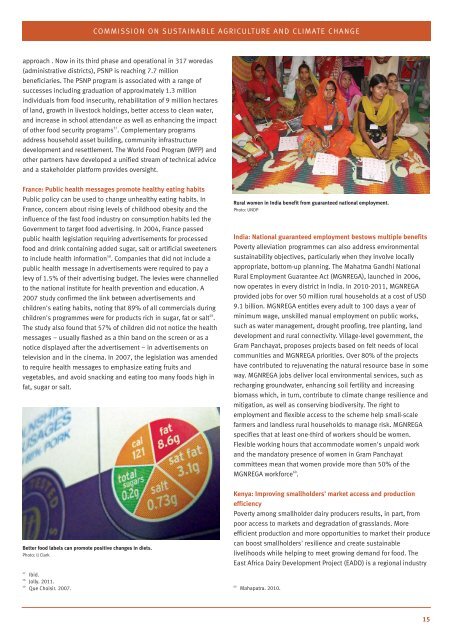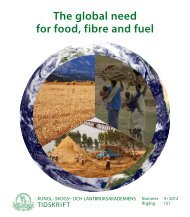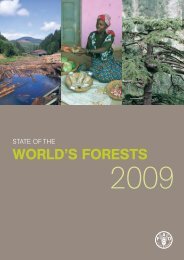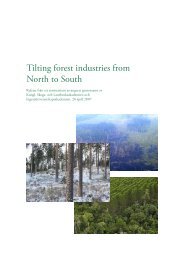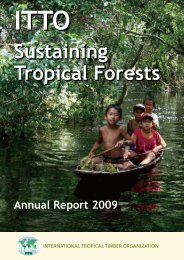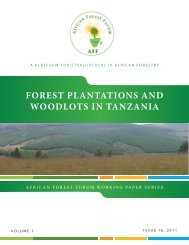Achieving food security in the face of climate change - CGSpace ...
Achieving food security in the face of climate change - CGSpace ...
Achieving food security in the face of climate change - CGSpace ...
Create successful ePaper yourself
Turn your PDF publications into a flip-book with our unique Google optimized e-Paper software.
COMMISSION ON SUSTAINABLE AGRICULTURE AND CLIMATE CHANGE<br />
approach . Now <strong>in</strong> its third phase and operational <strong>in</strong> 317 woredas<br />
(adm<strong>in</strong>istrative districts), PSNP is reach<strong>in</strong>g 7.7 million<br />
beneficiaries. The PSNP program is associated with a range <strong>of</strong><br />
successes <strong>in</strong>clud<strong>in</strong>g graduation <strong>of</strong> approximately 1.3 million<br />
<strong>in</strong>dividuals from <strong>food</strong> <strong>in</strong><strong>security</strong>, rehabilitation <strong>of</strong> 9 million hectares<br />
<strong>of</strong> land, growth <strong>in</strong> livestock hold<strong>in</strong>gs, better access to clean water,<br />
and <strong>in</strong>crease <strong>in</strong> school attendance as well as enhanc<strong>in</strong>g <strong>the</strong> impact<br />
<strong>of</strong> o<strong>the</strong>r <strong>food</strong> <strong>security</strong> programs 57 . Complementary programs<br />
address household asset build<strong>in</strong>g, community <strong>in</strong>frastructure<br />
development and resettlement. The World Food Program (WFP) and<br />
o<strong>the</strong>r partners have developed a unified stream <strong>of</strong> technical advice<br />
and a stakeholder platform provides oversight.<br />
France: Public health messages promote healthy eat<strong>in</strong>g habits<br />
Public policy can be used to <strong>change</strong> unhealthy eat<strong>in</strong>g habits. In<br />
France, concern about ris<strong>in</strong>g levels <strong>of</strong> childhood obesity and <strong>the</strong><br />
<strong>in</strong>fluence <strong>of</strong> <strong>the</strong> fast <strong>food</strong> <strong>in</strong>dustry on consumption habits led <strong>the</strong><br />
Government to target <strong>food</strong> advertis<strong>in</strong>g. In 2004, France passed<br />
public health legislation requir<strong>in</strong>g advertisements for processed<br />
<strong>food</strong> and dr<strong>in</strong>k conta<strong>in</strong><strong>in</strong>g added sugar, salt or artificial sweeteners<br />
to <strong>in</strong>clude health <strong>in</strong>formation 58 . Companies that did not <strong>in</strong>clude a<br />
public health message <strong>in</strong> advertisements were required to pay a<br />
levy <strong>of</strong> 1.5% <strong>of</strong> <strong>the</strong>ir advertis<strong>in</strong>g budget. The levies were channelled<br />
to <strong>the</strong> national <strong>in</strong>stitute for health prevention and education. A<br />
2007 study confirmed <strong>the</strong> l<strong>in</strong>k between advertisements and<br />
children's eat<strong>in</strong>g habits, not<strong>in</strong>g that 89% <strong>of</strong> all commercials dur<strong>in</strong>g<br />
children's programmes were for products rich <strong>in</strong> sugar, fat or salt 59 .<br />
The study also found that 57% <strong>of</strong> children did not notice <strong>the</strong> health<br />
messages – usually flashed as a th<strong>in</strong> band on <strong>the</strong> screen or as a<br />
notice displayed after <strong>the</strong> advertisement – <strong>in</strong> advertisements on<br />
television and <strong>in</strong> <strong>the</strong> c<strong>in</strong>ema. In 2007, <strong>the</strong> legislation was amended<br />
to require health messages to emphasize eat<strong>in</strong>g fruits and<br />
vegetables, and avoid snack<strong>in</strong>g and eat<strong>in</strong>g too many <strong>food</strong>s high <strong>in</strong><br />
fat, sugar or salt.<br />
Rural women <strong>in</strong> India benefit from guaranteed national employment.<br />
Photo: UNDP<br />
India: National guaranteed employment bestows multiple benefits<br />
Poverty alleviation programmes can also address environmental<br />
susta<strong>in</strong>ability objectives, particularly when <strong>the</strong>y <strong>in</strong>volve locally<br />
appropriate, bottom-up plann<strong>in</strong>g. The Mahatma Gandhi National<br />
Rural Employment Guarantee Act (MGNREGA), launched <strong>in</strong> 2006,<br />
now operates <strong>in</strong> every district <strong>in</strong> India. In 2010-2011, MGNREGA<br />
provided jobs for over 50 million rural households at a cost <strong>of</strong> USD<br />
9.1 billion. MGNREGA entitles every adult to 100 days a year <strong>of</strong><br />
m<strong>in</strong>imum wage, unskilled manual employment on public works,<br />
such as water management, drought pro<strong>of</strong><strong>in</strong>g, tree plant<strong>in</strong>g, land<br />
development and rural connectivity. Village-level government, <strong>the</strong><br />
Gram Panchayat, proposes projects based on felt needs <strong>of</strong> local<br />
communities and MGNREGA priorities. Over 80% <strong>of</strong> <strong>the</strong> projects<br />
have contributed to rejuvenat<strong>in</strong>g <strong>the</strong> natural resource base <strong>in</strong> some<br />
way. MGNREGA jobs deliver local environmental services, such as<br />
recharg<strong>in</strong>g groundwater, enhanc<strong>in</strong>g soil fertility and <strong>in</strong>creas<strong>in</strong>g<br />
biomass which, <strong>in</strong> turn, contribute to <strong>climate</strong> <strong>change</strong> resilience and<br />
mitigation, as well as conserv<strong>in</strong>g biodiversity. The right to<br />
employment and flexible access to <strong>the</strong> scheme help small-scale<br />
farmers and landless rural households to manage risk. MGNREGA<br />
specifies that at least one-third <strong>of</strong> workers should be women.<br />
Flexible work<strong>in</strong>g hours that accommodate women's unpaid work<br />
and <strong>the</strong> mandatory presence <strong>of</strong> women <strong>in</strong> Gram Panchayat<br />
committees mean that women provide more than 50% <strong>of</strong> <strong>the</strong><br />
MGNREGA workforce 60 .<br />
Better <strong>food</strong> labels can promote positive <strong>change</strong>s <strong>in</strong> diets.<br />
Photo: IJ Clark<br />
Kenya: Improv<strong>in</strong>g smallholders' market access and production<br />
efficiency<br />
Poverty among smallholder dairy producers results, <strong>in</strong> part, from<br />
poor access to markets and degradation <strong>of</strong> grasslands. More<br />
efficient production and more opportunities to market <strong>the</strong>ir produce<br />
can boost smallholders' resilience and create susta<strong>in</strong>able<br />
livelihoods while help<strong>in</strong>g to meet grow<strong>in</strong>g demand for <strong>food</strong>. The<br />
East Africa Dairy Development Project (EADD) is a regional <strong>in</strong>dustry<br />
57<br />
58<br />
59<br />
Ibid.<br />
Jolly. 2011.<br />
Que Choisir. 2007.<br />
60<br />
Mahapatra. 2010.<br />
15


